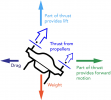IME, it's accelerates faster and has a faster top speed, therefore is faster and quicker. I don't think people universally mean top speed when they say fast, wrt drones.If you use the term "much faster" and then say you didn't mean it actually goes faster, I don't think it's pedantic of me at all to point that out.
You imagine wrong - all those things are irrelevant because in level flight the total motor thrust, T, has to be partitioned, via tilt, so that the vertical component is always equal to the weight of the aircraft, Mg. So at tilt θ,
Tcosθ = Mg (1)and
Tsinθ = Ma (2)Dividing equation (2) by equation (1) gives
a = gtanθIn other words the linear horizontal acceleration is only a function of tilt.
Then post some logs showing sustained flight faster than the DJI specifications.
If I cap the top speed of my FPV drone to 5 mph under the M2P/M3, I think most people will still (erroneously if being pedantic) claim that the FPV drone is faster because it accelerates at a significantly higher rate, although the top speed will still be slower. But, I suppose let's agree to disagree because we're not about to run an experiment to find out.
Of course what I was getting at is the motor and propeller difference between the M2P and M3 is such that the M3 has more thrust. Perhaps I wasn't clear when I said "Are props/motor rpm equal between them?" So, more thrust, more aerodynamic, and less weight... would lead me to believe it is faster.
I will concede that there are other variables such as stick rate and video transmission FPS that may alter the experience between them. I would love to see a poll and both drones tested in a scientific manner to settle this once and for all.











